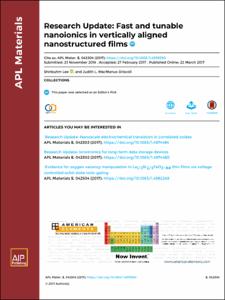Department of Physics and Chemistry
Multifunctional films and nanostructures Lab
1. Journal Articles
Research Update: Fast and tunable nanoionics in vertically aligned nanostructured films
- Title
- Research Update: Fast and tunable nanoionics in vertically aligned nanostructured films
- Author(s)
- Lee, Shinbuhm ; MacManus-Driscoll, Judith L.
- Issued Date
- 2017-04
- Citation
- APL Materials, v.5, no.4
- Type
- Article
- Keywords
- COLOSSAL IONIC-CONDUCTIVITY ; NANOCOMPOSITE THIN-FILMS ; EPITAXIAL ZRO2Y2O3/SRTIO3 HETEROSTRUCTURES ; DOPED CEO2 ; FUEL-CELLS ; INTERFACES ; RECHARGEABLE LITHIUM BATTERIES ; TRANSITION-METAL OXIDES ; STRAIN CONTROL ; ENERGY-STORAGE
- ISSN
- 2166-532X
- Abstract
- This review provides the design principles to develop new nanoionic applications using vertically aligned nanostructured (VAN) thin films, incorporating two phases which self-assemble in one film. Tunable nanoionics has attracted great attention for energy and device applications, such as ion batteries, solid oxide fuel cells, catalysts, memories, and neuromorphic devices. Among many proposed device architectures, VAN films have strong potential for nanoionic applications since they show enhanced ionic conductivity and tunability. Here, we will review the recent progress on state-of- the-art nanoionic applications, which have been realized by using VAN films. In many VAN systems made by the inclusion of an oxygen ionic insulator, it is found that ions flow through the vertical heterointerfaces. The observation is consistent with structural incompatibility at the vertical heteroepitaxial interfaces resulting in oxygen deficiency in one of the phases and hence to oxygen ion conducting pathways. In other VAN systems where one of the phases is an ionic conductor, ions flow much faster within the ionic conducting phase than within the corresponding plain film. The improved ionic conduction coincides with much improved crystallinity in the ionically conducting nanocolumnar phase, induced by use of the VAN structure. Furthermore, for both cases Joule heating effects induced by localized ionic current flow also play a role for enhanced ionic conductivity. Nanocolumn stoichiometry and strain are other important parameters for tuning ionic conductivity in VAN films. Finally, double-layered VAN film architectures are discussed from the perspective of stabilizing VAN structures which would be less stable and hence less perfect when grown on standard substrates. (C) 2017 Author(s).
- Publisher
- AIP Publishing
- Related Researcher
-
-
Lee, Shinbuhm
- Research Interests Multifunctional films; Experimental condensed matter physics
-
- Files in This Item:
-
 기타 데이터 / 18.98 MB / Adobe PDF
download
기타 데이터 / 18.98 MB / Adobe PDF
download
- Appears in Collections:
- Department of Physics and Chemistry Multifunctional films and nanostructures Lab 1. Journal Articles



